
as a reminder of Portland’s freeway-fighting past.
(Photo:
John Russell)
“Those who cannot remember the past are condemned to repeat it.”
–philosopher George Santayana
Much of the why Portland is a city where bikes, pedestrians, and transit can flourish, is because we have taken a stand against freeways. Two events coming up in November will educate a new generation about Portland’s proud history of freeway fighting and removal.
In the late 1960s and early ’70s, plans for the Mt. Hood Freeway (that would have run through the heart of Southeast Portland) were canceled after neighborhoods revolted and city planners threatened a lawsuit.
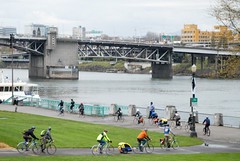
perhaps unaware that it used to be
a freeway.
(Photo � J. Maus)
In 1974, a piece of the 99W freeway (known as Harbor Drive) along the western shore of the Willamette River in downtown Portland was removed. In its place was put Tom McCall Waterfront Park, which stretches from the Steel Bridge to the Riverplace Marina — and Portland became the first major U.S. city to remove an existing freeway.
It’s important to note that both of these areas (Southeast Portland and the Waterfront) now see some of the highest levels of bike and pedestrian activity anywhere in the city.
On November 8th, the Architectural Heritage Center (AHC) presents, The Road Not Taken: The Mt. Hood Freeway and the Preservation of Southeast Portland. The presentation will,
“take a look back at the post-World War II era of freeway building in Portland, a time society became oriented around the automobile. How did Portland change from a bicycle and streetcar city in the early 20th century to a Freeway City by mid-century? Where did the idea come from that freeways could solve our traffic woes? And why did the freeway antagonists prevail in this case?”
This presentation is $18 for the general public and $13 for AHC members. More on the event at the AHC website.

edition of his Dead Freeways Ride.
(Photo: Carye Bye)
Then, on November 16, local urban historian and artist Shawn Granton will lead his Dead Freeways Ride. Shawn has led this ride for years and it’s always a hit. Here’s his description:
“What if…Portland built all the freeways it planned? This ride will follow the routes of several highways that never made it off the drawing board, such as the fabled Mt. Hood Freeway, some that did but were later removed, like Harbor Drive, and also as a reference some freeways that currently exist.”
The ride is free. More details at Shawn’s Urban Adventure League website.


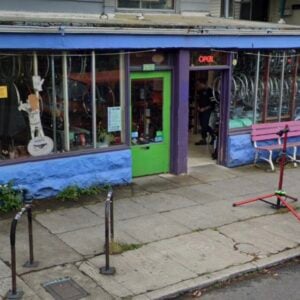
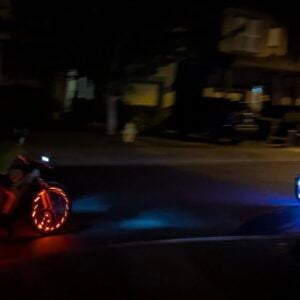
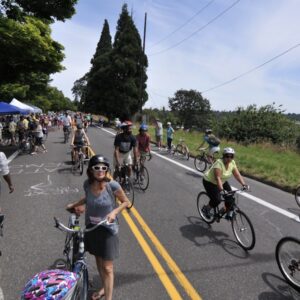
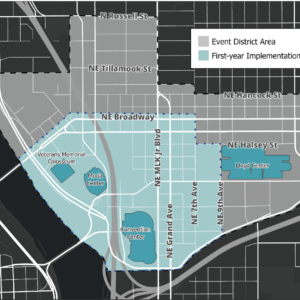
Thanks for reading.
BikePortland has served this community with independent community journalism since 2005. We rely on subscriptions from readers like you to survive. Your financial support is vital in keeping this valuable resource alive and well.
Please subscribe today to strengthen and expand our work.
These are fun and educational events…check them out.
I was on the Dead Freeways ride in 2006, and I just noticed that my boyfriend Damian is in that bottom picture! Eeeeerie how that happens; today would have been his 30th birthday, and I ran across a new picture of him in my regular blog reading today. Many thanks for posting about this.
For anyone thinking about going on the ride, I would definitely recommend it. Learning about the history of our freeway and greenspace development is very relevant to understanding why it’s so great to live in Portland.
Nicely written
Wasn’t the east side of the I-5 built to replace the removed section of the highway? Or was that already built.
Also can we make a habit of calling them highways and not freeways?
It’s a subtle change (like Global Warming vs. Climate Crisis) with profound impact.
‘Freeway’ implies both freedom to go as fast as you want and free to the user.
Both are believed to be true with disastrous consequences.
A ‘Free’way is not free, it’s actually the most expensive transportation infrastructure around (maybe excepting large airports), it’s not free (available) to everyone, and it definately does not provide freedom except perhaps at 1:00am.
peace
I don’t have my notes and sources by my side, but I believe the I-5 freeway on the east side (properly called the East Bank Freeway) was built as part of the overall freeway plan and was actually not built to replace the Harbor Drive expressway.
Your observation about the name “Freeway” is intriguing. Of course, freeways were called such because they are free of at-grade intersections, meaning you’re free of traffic signals and stopping for cross traffic.
Of course you aren’t free from traffic jams, that’s true.
At least we don’t call them “Parkway”, like they do on the East Coast. I can never wrap my mind around the concept of a high-speed throughway for traffic being equated to a park.
I like what the British call them: “Motorway”. Fits the bill rather nicely.
San Francisco was another city that removed a major freeway (the Embarcadero) after the 1989 earthquake. I couldn’t imagine the city without it at the time. Now, I can’t imagine how it was ever put in in the first place.
I’d often spied the eastbank maze of freeways in Portland along the waterfront as a horrendous eyesore and barrier to people easily interacting with the riverfront on that side (not unlike the Embarcadero of San Francisco was).
It bears noting, Jonathan, I don’t believe that first photo is the work of Shawn Granton. I should know�I took it this April: http://www.flickr.com/photos/jr98664/2409238877/in/set-72157604514274377/
I actually really appreciate the fact that you are using my photo, and I doubt the misattribution was in any way intentional. He probably got it off of the Wikipedia page on which I placed my photo.
The reason why I took the photo in the first place is actually just that I find this stuff quite interesting. I hope that my schedule stays open that morning.
Hey Jonathan, thanks for posting about this! Hope some of you out there can attend.
re: Aaron (post #3)- I-5 was not planned nor built with the intention of replacing Harbor Drive (US 99W), nor was I-405. When the Fremont Bridge was opened in 1973 (the 35th anniversary of its opening is coming soon, on Nov. 11th!), completing the central city freeway loop, Harbor Drive was made “redundant”. A vocal, organized group of folks helped consider the powers-that-be that Harbor Drive should go and it came down in 1974.
re: John (post #6)-Yep, got the photo from the wikipedia article, sorry. Now I know who did the photo!